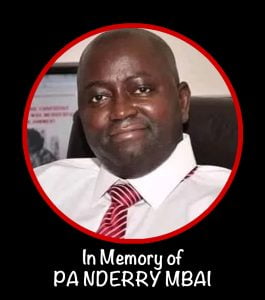
The gunman was wearing a kaftan, according to testimony given in court by Bakary R. Jarju, the second prosecution witness (PW2) in the Sukuta Traffic Light PIU officer shooting killings trial. This runs counter to the prosecution’s first witness’s evidence.
“The gunman I saw is a tall man whose skin tone I’m not sure about. I am unable to explain the color of the kaftan he was wearing. He has covered shoes and is quite slender. When asked to identify the gunman as an eyewitness, PW2 said to the court, “What I mean by a covered shoe is the kind of shoe that covers up to your ankle.”
The first prosecution witness, Ismaila Bojang, said in her testimony that the gunman had bowlegged pants and was dressed in a yellowish T-shirt.
The second prosecution witness, Bakary R. Jarju, said in his testimony that on the day of the shooting event, he, Bojang, and Omar Jallow traveled to the Senegambia beach for training. He claimed that they had been chosen to spend a month in Turkey receiving specialized training, which they did with success and returned there on October 23, 2023.
Jarju further said in her testimony that after the Maghrib prayers, they were given a ride to Sukuta Traffic Light Junction on their way back home following the training at the Senegambia beach. At the Sukuta Jabang Traffic Lights, they got off and made the decision to have takeout.
“We dispatched a lad named Omar Jallow to purchase Afra on our behalf. We make our way across the street. The road is split into two when I refer to it as the opposite side. As a result, we were behind three police officers on a balcony as we crossed to the opposite side. These three police officers sat on a chair; the first man was on the left, the second man was in the center, and the woman was on the far right.
The policeman in the middle of the group was the one with the rifle—an AK-47, to be exact. I heard a gunshot when we were beneath that veranda. I heard a gunshot right away, so I turned to face that direction. I observed the man who was down with an AK-47. My first opinion was that it seemed to be a careless dismissal. The other Policeman who had been seated on the left side started to get up. There was a gunman there as he stood. His want to steal the AK-47 is how I know there was a shooter. While he (the gunman) was fumbling with the other policeman, he shot the cop, he said.
Witness 2 (PW2) reported hearing three gunshots fired from a distance during his testimony. According to his account, the gunman opened fire first on the AK-47-wielding police officer, then on the cop to the left, and last on the female officer stationed far to the right.
Additionally, PW2 stated that the gunman moved away from the female officer and shot her one more time before making a break for the Sukuta Traffic Lights roundabout.
According to PW2, there were several people in the area when the gunman began fire. In his testimony, he claimed to have heard the sound of a handgun and to have recognized it as such as he is a skilled soldier with training in sound identification.
An AK-47 and a handgun make distinct noises. He simply raced and twisted to the right after firing the shot. Omar Jallow, Ismaila Bojang, and I then began pursuing him. We pursued him for a few meters before he fired a shot at someone I’m not sure of. He turned once again and fired a shot as we pursued him. He turned right away, however, and I noticed him, so I instructed Ismaila Bojang to hide. We picked the fence as cover because, in the event that someone brandishing a gun is a meter away from you and you fear for your life, all you have to do is go behind the object to take shelter.
We pursued him farther, and he proceeded to enter a rather unkempt, bushy structure. That place lacks an electrical infrastructure. I suggested to Ismaila Bojang that we try using this fence as a cover. “Let’s follow him there,” Ismaila responded. I ordered him to halt and informed him that while we are not armed, the shooter is. Second, PW2 said, “His ammunition is depleted. We could be in danger if we go inside because we are unarmed.”
PW2 said the court that he informed Ismaila Bojang that they couldn’t see the precise position of the gunman since the surroundings was dark. They returned to the crime site in order to gather evidence, including information on the sort of weapon the gunman used.
PW2 said that when looking for evidence with their phone flashlights, they discovered two empty bullet casings. Ismaila Bojang took one case, and he took up the other.
PW2 clarified that the primer, empty case, propellant powder, and bullet are the four primary parts of a round. The empty case is ejected from the pistol along with the bullet when it is fired.
I notified Ismaila Bojang (the owner of the bullet casing) that it was a live round as soon as I picked it up. The one that kills or damages is what I mean by the term “live round.” I could tell it was a live round the moment I saw the empty bullet casings. The bullet was gone because it was not there. So there was an officer throughout that period. His surname is Sowe, although I’m not sure what status he has. I persisted, even though he implored, “Please, soldier, talk to me.” He stated, “I didn’t realize he was a police officer, which is why I persisted. He was dressed in civil attire.
In response to a query on how the Sowe person found out he was a soldier, the witness told the judge that it was when the Infantry Battalion members showed up.
According to PW2, the Sowe person was escorted to the crime site by a PIU officer, who disclosed to them their military status at that point.
In addition, PW2 informed the court that the police officer revealed his identify as a CID officer after learning from PW2 that they were soldiers.
At this juncture, PW2 expressed his regret, saying he was not aware of the police officer’s position before.
PW2 said that once the police officer asked to speak with him about the event, PW2 granted his request.
“I agree that there are too many people here; let’s get to the pickup, he (CID) told me. He drives a white pickup truck. He told me what had transpired. I asked him if he could get me some water. I told him after I’d had a few drinks that we had just arrived from Senegambia when we heard a gunshot. We heard the sound of the gun as the gunman was shooting at the police officer, so I told him I didn’t know where the shooter was coming from. That’s when I gave Omar Jallow the empty bullet casings, and he gave them to Sowe,” he said.
The witness identified the gunman as a tall man when pressed to characterize him for the court.
“The gunman I saw is a tall man whose skin tone I’m not sure about. I am unable to explain the color of the kaftan he was wearing. He has covered shoes and is quite slender. Ankle-high shoes are what I mean when I refer to them as covered shoes. It was almost nine o’clock at this point, and my first concern was figuring out what kind of weaponry the shooter was using—the description I provided is the only way I can identify him.
Despite the fact that it was evening, these police officers were seated with lights on. There were around twenty to twenty-five meters between where we were and where these police officers were. When PW2 was asked to identify the gunman as an eyewitness, she informed the court, “So that’s why I was able to see what was happening because of the lighting system.”
When Ousainou and Amie Bojang first appeared in front of Principal Magistrate Omar Jabang of the Kanifing Magistrates’ Court on September 21, 2023, they were charged with crimes pertaining to the shooting incident at Sukuta Jabang Traffic Lights, which on September 12, 2023, claimed the lives of two PIU officers and seriously injured another.
At first, the accused was facing four accusations from the police: two counts of murder, one count of terrorism, and one count of accessory after the fact to murder. The murder trial was then moved to the Special Criminal Division of the High Court of The Gambia by Principal Magistrate Omar Jabang.
The matter was brought before Hon. Justice Ebrima Jaiteh of the Gambia High Court on October 12, 2023.
Six charges and one charge were filed by the State on October 19, 2023, against Ousainou Bojang, the main suspect in the killings of two Police Intervention Unit (PIU) officers, and his older sister, Amie Bojang.
Ousainou and Amie Bojang filed not guilty pleas to the charges on October 24, 2023. The state then introduced its first prosecution witness.
The case has been postponed to November 7, 2023, so that the hearing may continue and the first prosecution witness can be cross-examined.


